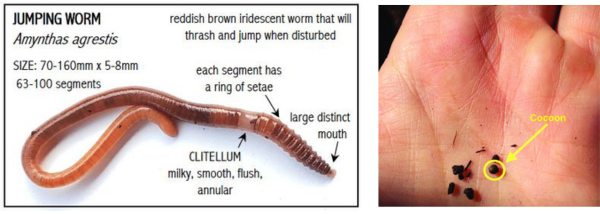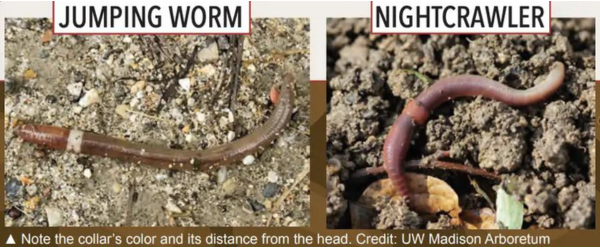Jumping worms are invasive earthworms belonging to several genera including Amynthas, Metaphire and Pheretima. Native to the grasslands of East-Central Asia, they were introduced to North America in the late 1800s. In Canada, small populations have been seen in southern Ontario (including Toronto, Hamilton and Windsor), New Brunswick and Nova Scotia.
Jumping worms are unique in that they can reproduce asexually without mating. This means that a single worm introduced into a new space can start an entire population. As such, jumping worms are successful at invading lawns and forests, which is threatening the balance of local ecosystems, including our urban forest.
Identifying Jumping Worms in Your Yard
Identifying jumping worms in your yard can be quite the challenge! Eggs begin to hatch between April and May, with juvenile worms becoming noticeable between May and August as they feed and mature. The easiest time to spot jumping worms is between August and September when adults are at their largest.

Here are some key characteristics to look for:
- Adult Appearance – Adults are up to 16 centimetres in length with smooth, glossy and rubbery skin. They have a characteristic milky-white collar called a clitellum near the head, which creates a full ring around the body.
- Adult Behaviour – When disturbed, jumping worms thrash wildly back and forth or “jump” to flip over, earning them such nicknames as “crazy worms” or “snake worms.” If a predator is not deterred by their defensive dancing, jumping worms can shed parts of their tail to evade harm.
- Egg/Cocoon –The eggs are enclosed in tiny cocoons that resemble mustard seeds. Eggs overwinter before hatching and are present from late fall into early spring, but are hard to spot given their size.
- The soil (and worm poop!) – Adults create lots of loose, crumbly poop called casts that look like coarse coffee grounds. Casts create a loose layer between leaf litter and the soil beneath.
Look-alike Alert! Nightcrawlers (Lumbricus spp.) are often mistaken for jumping worms. Nightcrawlers have a raised pink-red collar positioned more in the middle of their body while jumping worms have their milk-white collar closer to the head.

Impact on the Local Environment
Jumping worms can profoundly impact the urban forest ecosystem by altering soil structure and reducing biodiversity. Jumping worms outcompete other beneficial earthworm species in both number and appetite. As they move along the top layer of soil in mass numbers, they devour organic material and convert the soil into granular, loose castings. What’s left behind is a soil structure that is less effective at holding onto water and more susceptible to erosion and nutrient loss. Jumping worms also change the nutrient composition of the soil, making it richer in nitrogen. These combined changes alter which plants, bacteria and fungi can grow and survive in the soil. Jumping worm infestations make it difficult for many plants to thrive, ultimately reducing biodiversity.

Early Detection & Prevention
Jumping worms have only recently arrived in Ontario, so the most effective and low-cost solution for managing their spread is prevention and early detection. Here are six steps you can take to slow the spread of jumping worms in the urban forest:
- Learn how to recognize the presence of jumping worms in your yard and share your knowledge with others.
- Do not use jumping worms for bait, composting or gardening.
- Avoid purchasing/transporting soil, mulch or plants from areas outside of Ontario with established jumping worm infestations, as egg-filled cocoons may be hidden inside these products.
- Check your property periodically for signs of jumping worms by raking leaves and inspecting soil.
- Clean compost, soil and debris from vehicles, personal gear (clothing and boot treads), equipment and gardening tools when moving between locations, as eggs may stick to surfaces.
- The recommended way to euthanize worms is by freezing or leaving in a sealed bag in the sun, then discard. Worms may also be euthanized using rubbing alcohol. Treat any possibly contaminated soil as if it contains worms by sealing in a clear plastic bag and leaving in the sun before disposing in the trash.
- If you find a jumping worm, report it on the Invasive Species Centre's website or on iNaturalist!
By raising awareness and implementing proactive measures to identify, manage, and prevent the spread of jumping worms, we can ensure that the health and balance of our urban forests and local ecosystems remains preserved.
Jon is an ISA certified arborist and the Residential Planting Programs Field Coordinator at LEAF
LEAF offers a subsidized Backyard Tree Planting Program for private property. The program is supported by the City of Toronto, the Regional Municipality of York, the City of Markham, the Town of Newmarket, the Regional Municipality of Durham, the Town of Ajax, the Township of Brock, the Municipality of Clarington, the City of Oshawa, the City of Pickering, the Township of Scugog, the Town of Whitby and Ontario Power Generation.
